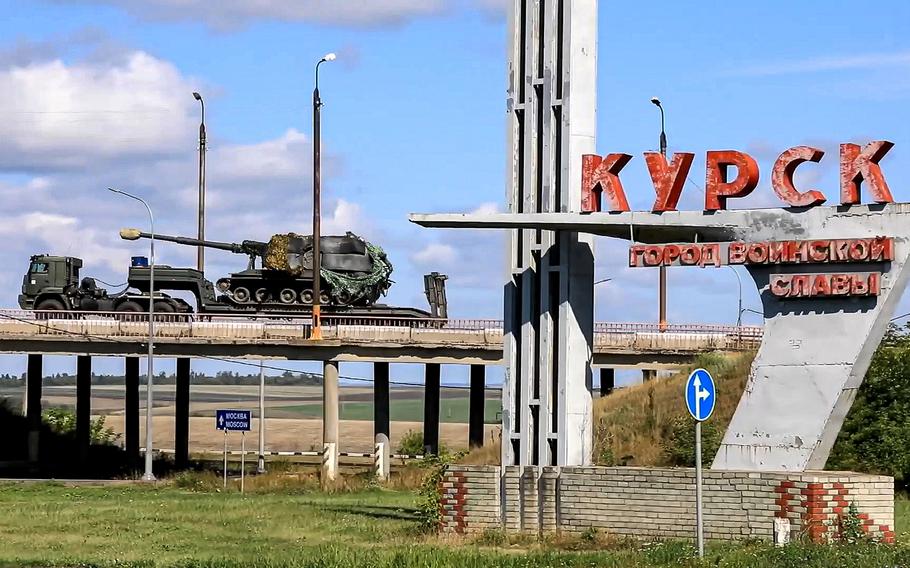Europe
Ukrainian incursion in Kursk struggles as Russians retake territory
The Washington Post October 25, 2024

In this photo taken from video released by the Russian Defense Ministry on Aug. 9, 2024, a Russian military column moves to fight Ukrainian forces in the Sudzhansky district of the Kursk region of Russia. (Russian Defense Ministry Press Service via AP)
KYIV — As President Volodymyr Zelensky toured Europe and the United States to pitch his “victory plan” for how to end the war with Russia, Ukrainian forces suffered new setbacks on the battlefield — including, analysts say, ceding up to half of the territory Kyiv claimed during its cross-border offensive into Russia’s Kursk region this summer.
The surprise incursion into Russia had been hailed as a success by Ukrainian officials because it led to the capture of hundreds of Russian troops who could be exchanged for Ukrainian prisoners. But recent Russian counterattacks in Kursk have cast doubt on how long Kyiv will be able to continue holding the territory.
The Institute for the Study of War, which has been monitoring the conflict, cited visual evidence that Russian forces have recaptured 46 percent of the Ukrainian salient in the Kursk region. Ukraine’s Ministry of Defense has declined to reply to questions about the situation.
Russian President Vladimir Putin asserted that pockets of Ukrainian forces there were encircled, a statement sharply contested Friday by Oleksandr Syrsky, commander of Ukraine’s armed forces.
“Ukrainian forces continue active operations in the Kursk direction, for the third consecutive month, destroying the enemy’s combat potential,” he posted on Telegram. “Despite the immense pressure from the enemy on this front, the occupiers are suffering significant losses in personnel and military equipment.”
Ukraine’s latest losses in Kursk underscore how the country has struggled militarily amid discussions on ending the war. Russia has been making steady gains in Ukraine’s eastern Donetsk region all year and recently made new advances in the northeastern Kharkiv region in an attempt to reach the city of Kupyansk, which Ukrainian forces liberated from occupation two years ago.
Kyiv’s land grab in the Kursk region was included by Zelensky in his victory plan, and Ukrainian officials have presented the incursion as a potentially powerful bargaining chip in any future peace negotiations. But Russia’s latest advances could cast the risky offensive in a new light.
“I don’t think we can talk about the large-scale Russian offensive that could push the Ukrainians out just yet,” said Franz-Stefan Gady, a Vienna-based military analyst. “I think we’re still in a shaping phase — that is, in a preliminary phase before a larger-scale assault — and the major objective of the Russian forces currently is to [weaken] Ukrainian forces with artillery and drone strikes.”
“They’re essentially just testing the weaknesses of the Ukrainian defenses, so the incursion’s still fairly limited. And I think what’s concerning is that the Ukrainians are indeed actually already in this phase of being pushed back,” he added.
After Ukrainian forces caught the Russians by surprise, Moscow committed more than 50,000 troops to defend the region, Ukrainian officials said. But the incursion failed to divert Russia’s assault in Ukraine’s eastern Donetsk region, where Moscow’s forces have continued to threaten the key rail hub of Pokrovsk and surrounding villages.
Ukraine’s military intelligence agency said it now expects Russia to send in new reinforcements to the Kursk region, including some of the thousands of North Korean soldiers that the agency says have been training in Russia in preparation to join the war effort. That could enable Moscow to divert some soldiers fighting in Kursk to other parts of the battlefield.
Ukraine, meanwhile, has committed some of its top Western-provided arms and assault brigades to the Kursk incursion. A Western military official, who spoke on the condition of anonymity to discuss a sensitive matter, estimated that at least 10,000 Ukrainian soldiers were fighting in Kursk, including brigades that received special training abroad.
Russia has the advantage of numbers in the area, but with Ukrainian forces already under strength at other parts of the front, sending more troops to Kursk could significantly weaken their defenses, especially in the embattled east.
Konrad Muzyka, a military analyst for Rochan Consulting in Poland, said the Russians have maintained some 33 units in the area — an increase from 12 in mid-August — and the Ukrainians have deployed about 23 units altogether.
“Personnel and resources allocated to Kursk would be put to good use in the Donetsk Oblast, likely decreasing the tempo of Russian advances in this part of Ukraine,” Muzyka said. “The Ukrainian political-military leadership must have concluded that from the strategic perspective, this commitment to Kursk was worthwhile even if that meant a loss of territory in Donbas.”
“The more terrain Russians retake, the less valuable Kursk will be for the Ukrainians,” he added. “So the Ukrainians need either to commit more units to the area or to attack elsewhere to impose a dilemma on the Russians. The problem is that Ukrainians do not seem to have a spare capacity at the moment for such moves.”
One of the Kursk’s offensive’s initial goals — to pull Russian troops to Kursk and weaken its attacks elsewhere — appears to have failed, analysts said. Russia has maintained the main thrust of its invasion in eastern Ukraine, attacking around the flanks of Pokrovsk and also south around Kurakhove.
Still, to completely expel the Ukrainians from the area will require a larger Russian force, which could give the Ukrainians a favorable attrition ratio to take advantage of, analysts said. However, that will also come at a cost to Kyiv.
“It’s unclear how strong Ukrainian defenses are in the area,” Gady said. “And I think Ukrainians have committed some operational reserves to the fight in the Kursk region.”
Serhiy Morgunov contributed to this report.